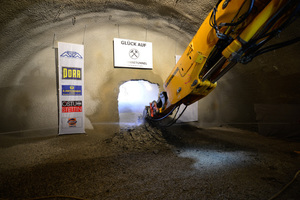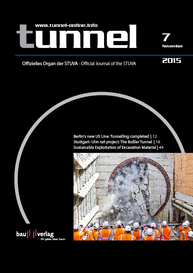Steinbühl Tunnel Breakthrough six Months earlier than planned
The breakthrough of the Steinbühl Tunnel was achieved at the Todsburg portal on 21 September 2015, six months earlier than scheduled. At the ceremonial event in Hohenstadton on 6 November, Georg Brunnhuber, chairman of the Stuttgart–Ulm rail project association, greeted guests including the minister for finance and industry of the state of Baden-Württemberg, Nils Schmid; the parliamentary secretary for transport, Norbert Barthle; the chairman of DB Projekt Stuttgart–Ulm GmbH, Manfred Leger; the managing director (COO) of Porr AG, Hans Wenkenbach and the mayor of Hohenstadt, Günter Riebort.
The Steinbühl Tunnel is one of two tunnels in the approximately 15 km long planning section 2.2 on the new line (NBS) from Wendlingen to Ulm. In this section, the line climbs up the Swabian Alb, with most of the climb being overcome in the 8.8 km long Boßler Tunnel – the longest tunnel on the new line. At Wiesensteig, the line emerges briefly on the surface to cross the Filstal valley at a height of about 85 m on two single-track bridges. The rest of the climb takes place in the 4.8 km long Steinbühl Tunnel. On the climb, gradients of between 17 and 25 ‰ have to be overcome.
“It fills me with pride and joy that the excavation of the first of the eight large tunnels has now been completed”, said Brunnhuber at the ceremony. Manfred Leger added: “My great respect is due to the miners and engineers from German Railways and the contactor. The speed with which the tunnel was excavated is impressive, although the geological conditions of the Alb ascent can definitely be considered difficult. With this achievement, we have all made a decisive contribution to the excavation of nearly a third of all tunnels in the overall project by the end of this year.” For Hans Wenkenbach, one fact was quite clear from the construction of the Steinbühl Tunnel: “Even in a challenging environment, a project can be successfully implemented without delays and avoidable extra costs as long as client and contractor communicate at eye level.”
On the day after the breakthrough ceremony, the general public also demonstrated great interest in the progress of the project: a good 6000 visitors took the chance to visit the site. In addition to such site open days, the Stuttgart–Ulm rail project association together with the project company also offers guided tours of the site, including the Steinbühl Tunnel. These tours are mostly booked up to the end of 2016 due to the great demand.
The “big eight” Tunnels on the Stuttgart–Ulm Rail Project:
1. Filder Tunnel (length: 9468 m; S21; PFA 1.2; when complete it
will be the third longest rail tunnel in Germany as of 30 October
2015)
2. Boßler Tunnel (length: 8806 m; NBS; PFA 2.2; when complete it
will be the fifth longest rail tunnel in Germany as of 30 October
2015)
3. Albvorland Tunnel (length: 8176 m; NBS, PFA 2.1ab)
4. Albabstieg Tunnel (length: 5940 m; NBS; PFA 2.4)
5. Ober-/Untertürkheim Tunnel (length: 5730 m; S21; PFA 1.6a)
6. Steinbühl Tunnel (length: 4847 m; NBS; PFA 2.2)
7. Bad Cannstatt Tunnel (length: 3507 m; S21; PFA 1.5)
8. Feuerbach Tunnel (length: 3026 m; S21; PFA 1.5)







